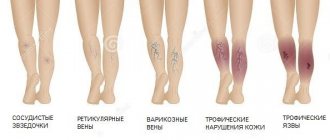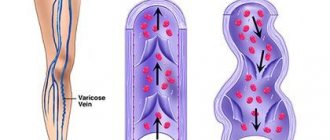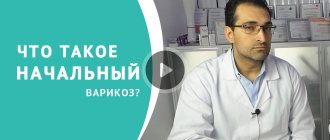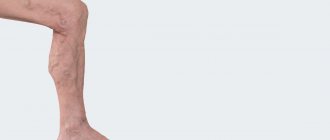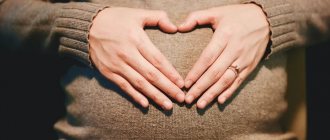- home
- Services and prices
- Phlebology
Varicose veins (VV) is a fairly common disease that affects both men and women. It can affect the lower limbs of a person, as well as deep veins, leading to the development of thrombosis and post-thrombophlebitis disease.
Spider veins that appear on a person’s legs as a result of the development of the disease become the reason that he begins to feel unattractive. In addition to external ones, there are also internal manifestations of explosives, which are expressed in the appearance of discomfort and pain in the calf muscles of the leg. The development of the disease increases the risk of other pathologies of the circulatory system.
The key to success in the fight against pathology lies in timely diagnosis and competent treatment. A big mistake on the part of a person is the independent use of various ointments and creams, which in most cases do not bring the desired effect. As a result, time was lost that could have been spent on proper and effective therapy.
In order to get rid of varicose veins, you need to solve the following problems:
- Elimination of symptoms.
- Removal of varicose veins.
- Prevention of the development and reappearance of explosives.
Only a highly qualified specialist with sufficient experience in the treatment and prevention of pathologies of this kind can successfully cope with each of the above tasks. These are the specialists who work at the Yuzhny Medical Center. The high level of qualifications of doctors in combination with the latest equipment will make it possible to make the correct diagnosis and carry out competent therapy, guaranteeing the absence of progression or recurrence of varicose veins of the lower extremities.
Symptoms of varicose veins
Symptoms of a disease are signs that clearly indicate its development. They are divided into:
- Subjective: Mild and aching pain in the calf muscles.
- A burning sensation and itching along the veins affected by varicose veins.
- Heaviness in the legs, increasing towards the end of the day.
- Skin hyperpigmentation.
- Increased fatigue of the lower extremities.
- Trophic venous ulcer of the leg.
- Pain in the calf muscles, aggravated by walking.
- The appearance of swelling in the lower legs and feet.
- Varicose veins of the saphenous veins, which are clearly visible even without the use of special equipment.
What veins look like
The very first warning sign of problems with the veins is swelling of the lower extremities at the end of the day. Swelling is especially pronounced if a person spends most of the day standing on his feet. It can disappear in the morning after a night spent resting.
However, if you do not pay due attention to this problem, the condition can worsen significantly. Intradermal veins in the legs with varicose veins become dark blue, protruding above the surface of the skin of the legs and feet. Outwardly, they look like bunches of red grapes that are overripe. Such external manifestations of pathology are accompanied by pain in the calves, a feeling of heat in the legs, swelling and cramps in the calf muscles. Over time, these symptoms are accompanied by a change in the appearance of the skin.
Treatment of varicose veins
Conservative treatment options
- Drug therapy does not cure varicose veins, but with the help of drugs, valve function, vascular trophism, blood circulation are partially improved, and the risk of thrombosis is reduced.
For this purpose, venotonics are used (Detralex, Troxivazin, Lyoton gel, etc.). They can be prescribed for any type of varicose veins. Ointments with nonsteroidal anti-inflammatory drugs (Indomethacin, Diclofenac, etc.) are indicated for thrombophlebitis. Also in this situation, anticoagulants are used (Heparin, Clexane, Fraxiparine, etc.), which effectively resolve blood clots. Treatment should be selected by a doctor, after a thorough diagnosis and taking into account the characteristics of the patient. - Herbal medicine and additional techniques are of auxiliary value. It is advised to wear compression stockings, do gymnastics, skiing, cycling, and swimming. The “bicycle” exercise in a supine position, flexion and extension of the feet, gives good results; it improves the outflow of blood from the extremities. You can do the exercises if there are no complications. It is also recommended to take a contrast shower in the morning (water your leg first with warm water, then gradually reduce the temperature to cold). Cool baths with decoctions of oak bark, horse chestnut, chamomile, St. John's wort, rubbing the skin with tincture of white acacia flowers, Kalanchoe leaves, and apple cider vinegar help. Leeches help get rid of thrombophlebitis.
- Mode. You need to get out of bed slowly, 5-10 minutes. Your legs should be raised 10-15⁰ at night; to do this, place a cushion under your heels. You need to walk calmly, it is undesirable to cross your legs when sitting, and do not overwork. All patients are advised to wear compression stockings.
- You need to eat right, include coarse fiber and foods rich in vitamins in your menu. Citrus fruits, tomatoes, rose hips, black currants, nuts, legumes, liver, onions, eggs, and seafood will be useful. It is important not to drink alcohol, not to smoke, and to drink enough water during the day. For persistent constipation, it is recommended to drink a laxative.
Surgery
Phlebectomy or complete removal of veins
The indication for such a radical operation is varicose veins, which involve a large number of veins. At the same time, there are complications - trophic ulcers that are difficult to treat, thrombophlebitis, persistent swelling in the legs, general symptoms (fatigue, dizziness, fainting).
The operation is contraindicated in case of ischemic heart disease, severe infections, in very old patients, in the second half of pregnancy, in case of local inflammation of the legs (erysipelas, pustular rashes, eczema). Only surgery can radically rid the patient of varicose veins and restore the function of the valves. If the situation is too severe, untreated and neglected, this method of treatment remains the only one. The disadvantages of the intervention are the need to give anesthesia and keep the patient in the hospital for several days under observation, postoperative trauma with scars.
Laser therapy (endovascular microthermocoagulation)
Laser treatment of varicose veins is used if the pathology is combined with diseases of the cardiovascular system (CHI, hypertension), changes in peripheral vessels (phlebitis, thrombophlebitis), diseases of the respiratory system (asthma, chronic bronchitis, pleurisy), gastrointestinal pathologies (cholecystitis, ulcers, peritonitis ), nervous system (FM injuries, meningitis, encephalitis and their consequences), genitourinary system (inflammation of the kidneys, prostate, pathology of the uterus with appendages), with skin diseases (furunculosis, dermatitis, psoriasis, etc.).
Contraindications to the use of laser are oncology, decompensated pathology of the kidneys, liver, heart, cerebral sclerosis, pregnancy.
The main advantages of laser therapy are its effectiveness in eliminating dilation of superficial veins, speed (duration of manipulation is 15-20 minutes), no need to go to the hospital, and low trauma. Among the disadvantages, it is worth highlighting the poor accessibility of the technique; not all clinics have the appropriate equipment. Treatment is expensive and is of little use for severely affected and deep veins. If the laser is used incorrectly, you can get a thermal burn, and sometimes depigmentation occurs at the sites of exposure.
Radiofrequency coagulation (ablation)
The operation is indicated for extensive lesions of the saphenous veins, trophic ulcers resulting from long-term and untreated varicose veins.
Radiofrequency coagulation is contraindicated in acute thrombophlebitis, limited mobility of the patient, pregnancy, and mental disorders.
The main advantages of the method are its painlessness, absence of injury, and the need for hospital stay. Patients can return to normal activities the very next day.
The disadvantage is the high cost of the intervention.
Sclerotherapy
Indicated for varicose veins of small and large superficial veins (on large vessels it is carried out under the control of duplex Doppler ultrasound) in the initial stage and without complications. Pregnant and nursing mothers, allergies to drugs, deep vein thrombosis, infectious and inflammatory skin lesions on the legs are not treated with this method. The main advantages are low price, quick recovery, no need for hospitalization. The procedure leaves no marks and does not cause injury.
The disadvantage is the risk of the sclerosing drug entering a deep vein, reduced effectiveness upon contact with blood, and the ability to use only in the initial stages.
Causes of varicose veins of the lower extremities
VV of the lower extremities can develop under the influence of a number of factors and circumstances, the main ones being:
- Pregnancy. This is a key risk factor for the disease. This explains the fact that varicose veins occur several times more often in women than in men. In this case, the disease develops under the influence of an increase in the volume of circulating blood and compression of the retroperitoneal veins of the pregnant uterus.
- Obesity. The connection of this condition with the development of VV has been proven by a number of studies. At the same time, a direct connection was found between increased body weight and an increased risk of developing pathology.
- A lifestyle characterized by prolonged static loads with regular heavy lifting or prolonged immobility in a standing or sitting position.
- Dishormonal conditions. Their role in the development of the disease has increased significantly over recent years. This is due to the widespread use of hormonal contraceptives, the spread of hormone replacement treatment for osteoporosis and during the premenopausal period
- Heredity. The role of this factor in the development of varicose veins on the legs has not been unambiguously confirmed today.
- A disorder of the valvular apparatus of the veins, leading to a downward flow of blood under the influence of gravity every time a person stands up. The muscles that are located around the deep veins contract as you walk. These veins are subject to emptying, causing venous pressure to increase. Blood enters the superficial veins through communicating vessels with insufficient valves. As a result, they are filled with blood, which leads to their stretching and expansion (varicose veins).
Varicose veins complicated by venous eczema
Against the background of existing swelling, foci of hyperemia (redness), exfoliation of the epidermis (peeling of the skin) appear, accompanied by itching of the skin. This complication already brings significant discomfort to the patient’s life and most often forces him to seek medical help. Often such patients can be treated by a dermatologist for a long time without success. It is very important that at this stage the patient still reaches a good phlebologist. Only in this case will he be provided with truly adequate medical care.
Venous eczema
Classification and stages
Like any disease, VV has several stages, differing from each other in the degree of spread of the pathology and symptoms. Among them, the following stages are distinguished:
- Initial (or compensation).
- Second (or subcompensation).
- Third (or decompensation).
A detailed description of each stage can be found here.
It is worth noting that complications can occur at any of the above stages, but their greatest likelihood is inherent in the last two. VV can serve as an impetus for the development of diseases such as:
- Thrombophlebitis.
- Erysipelas.
- Deep vein thrombosis.
- Trophic eczema.
A visit to a specialist, made at the first signs of the disease, will help reduce the risks of worsening the situation and begin removing varicose veins. You should not ignore even minor symptoms, because this can lead to undesirable and extremely negative consequences.
How to prevent consequences?
Varicose veins are directly related to numerous skin disorders, such as erysipelas, redness or blue discoloration, milky edema, dermatitis - due to the penetration of pathogenic microflora into weakened veins. However, not all complications are pronounced: in 6-15% of cases, the formation of blood clots is not accompanied by noticeable changes until they become irreversible.
The treatment methods used by our clinic solve the problem of varicose veins even in the later stages, but often people try to treat the consequences of varicose veins without understanding the causes of the changes. Comprehensive diagnostics can track varicose veins at stages when compression therapy is sufficient to treat them. And if you suffer from rapid leg fatigue, accompanied by pain and swelling, we recommend that you do not put off your visit to a phlebologist.
Diagnostics
Diagnosis of varicose veins, the symptoms of which are described above, poses the following tasks:
- Determining the presence of pathology in each individual patient. It often happens that people who do not have varicose veins are confident in their presence, and vice versa. However, only an experienced phlebologist, based on an external examination and a series of comprehensive studies, can make an accurate diagnosis.
- Establishing the type characteristic of venous pathology. The doctor determines exactly which veins have undergone pathological damage, and also establishes the extent of this damage and possible or already occurring consequences.
- Prescribing the correct course of treatment. Based on the diagnosis and the characteristics of each specific organism, the attending physician makes a choice in favor of one or another treatment or a set of therapeutic measures.
- Assessment of the level of effectiveness of therapy, which is carried out by the attending physician during the elimination of the disease or after the patient’s complete recovery.
The main methods for diagnosing VV include:
- Plethysmography.
- Thermography.
- Magnetic resonance imaging.
- Ultrasound angioscanning.
- Computed tomography.
- Clinical studies: conversation with the patient, his external examination and manual examination.
- Radionuclide phlebography.
- Intravascular ultrasound.
- X-ray phlebography.
Most often, it is enough for a professional specialist to conduct a clinical examination and ultrasound angiography in order to diagnose varicose veins in the legs. At the Yuzhny clinic, you can undergo a full examination in order to make an accurate diagnosis by an experienced phlebologist. Our specialists work closely with clients, clearly explaining to each of them the specifics of the disease and possible ways to combat it.
Treatment methods
Modern methods of treating varicose veins are aimed at reducing the degree of disability and trauma, which contributes to a faster recovery of the patient. Main therapeutic techniques include:
- Sclerotherapy. This method involves introducing a special medication into the lumen of varicose veins of the legs, causing a chemical burn of the internal venous wall. This leads to their gluing and cessation of pathological blood flow through them. Can be used alone or in combination with other types of manipulation. It is carried out without prior anesthesia with skin punctures using a thin needle. The duration depends on the scale of the lesion.
- Foam sclerotherapy, which involves the preparation by a specialist of a special medication of foam that can use an impressive area of the internal walls of the affected venous vessels. Used to treat large diameter veins.
- Endovenous laser coagulation, which is performed using a laser device on the main trunks of the leg veins and allows you to stop the pathological flow of blood through the affected veins due to the burn of their inner walls and their subsequent gluing. Laser treatment for varicose veins is available at the Yuzhny Medical Center.
- Miniphlebectomy, aimed at eliminating subcutaneous nodes and tributaries enlarged by varicose veins through punctures of the skin. It has excellent cosmetic effects and is used alone or in combination with other therapeutic methods under local anesthesia.
- Elimination of incompetent perforating veins, performed for the prevention of venous insufficiency and treatment of trophic disorders, including ulcers.
- Combined phlebectomy, which is a combination of some methods of treating veins, based on the indications and nature of venous pathologies.
Yuzhny Medical Center offers its clients modern approaches to the treatment of varicose veins. Qualified specialists work here, ready to conduct a competent examination in order to make a diagnosis and carry out effective treatment, more about which you can read here.
Complications with varicose veins
It is worth understanding that improper treatment of the disease or complete refusal of it can lead to complications. The latter appear not only in cosmetic defects of the lower extremities, but also in more serious forms. Among them:
- Trophic eczema, which subsequently develops into an ulcer.
- Thrombotic lesions of the venous system, including thrombophlebitis of the superficial veins and deep vein thrombosis of the lower extremities.
Venous blood is a kind of “sewer” for the body’s tissues and is saturated with substances and products of cell metabolism that are relatively harmful to the human body. Cells of the skin and subcutaneous tissue, as well as muscles and bones, discharge products of tissue respiration and other waste material into the venous system, which carries them to the heart, lungs, kidneys and liver. In case of disturbances in the functioning of the venous system, the content of these products in the tissues of the body increases.
A vein dilated by varicose veins leads not only to an increase in the concentration of harmful products in the tissues, but also to an increase in their swelling. This disruption of the outflow of harmful products, combined with swelling observed over a long period of time, leads to the death of skin cells and subcutaneous tissue and their subsequent replacement by venous eczema, represented by a dense and dotted structure of a dark color. The death of the surface layer of the skin is the cause of trophic ulcers.
How are the veins in the legs arranged?
The legs have two groups of venous vessels: superficial and deep or deep. The first are located in the subcutaneous tissue, that is, on the surface of the leg. The latter are located deeper, in the thickness of the muscles, next to the arteries and tendons. The deep and superficial vessels are connected by perforating or perforating veins. Their wall consists of collagen and elastin fibers, with weak and few smooth muscles. The venous wall has a three-layer structure:
- At the top is the adventitia, which is composed of loose connective fibers, smooth muscle cells elongated along the walls, surrounded by small capillaries and nerves responsible for the trophism of the vessel.
- In the middle is the media, consisting of circular smooth muscle fibers.
- The intima is located on the inside. The basis of the intima is the endothelium; between its cells there are longitudinal fibers of smooth muscles. The inner shell is folded, the thickenings are opposite each other and resemble swallows' nests or patch pockets. They are called valves and are responsible for the correct direction of blood flow.
Venous valves direct blood from the peripheral parts to the heart, as well as from the superficial to the deep veins. They prevent reverse outflow and increase venous pressure. In addition to the valves, smooth muscles, tendons and muscles of the leg take part in maintaining normal tone. When any of the layers (usually the median and internal layers) are damaged, the veins lose their tone and expand, and varicose veins occur.
- There are several superficial veins:
- The great saphenous vein is located on the inside of the leg; its walls are equipped with several valves; blood from the anterior femoral surface is collected into this vein through a series of smaller vessels.
- The small saphenous vein is located on the outside of the leg, equipped with valves, and collects blood from the veins on the front and back of the leg.
Communication between the large and small veins occurs through connecting vessels.
- The deep veins are the posterior and anterior tibial veins, the popliteal vein, and the femoral vein. Varicose veins develop in them at advanced stages, when the disease is not treated for a long time.
Prevention
Varicose veins on the legs, which are treated today using various methods, can be avoided by following preventive measures. Due to the fact that the risk of developing VV is much higher in women, it is they who need to not ignore the prevention of this disease. However, men should also not ignore preventive measures aimed at preventing the development of varicose veins in the legs. Key activities include:
- The use of local preparations (gels, ointments, creams) that help strengthen the walls of blood vessels, optimize the functioning of valves, reduce the risk of blood clots, eliminate swelling and heal wounds.
- The use of knee socks, tights, stockings and elastic bandages that have a compression effect. This is an excellent tool in the fight against varicose veins. These products can be purchased in specialized stores after consultation with a doctor, which is necessary due to the relative difficulty in independently determining the required type of compression garments.
- Specific exercises performed on a daily basis. They are able to stop even the dilation of blood vessels that has already begun. It should be borne in mind that if you have a tendency to BB, you will have to give up heavy physical activity, but in no case should you ignore an active lifestyle. For example, light jogging, swimming, yoga and skiing help maintain healthy leg veins.
- Preventive tablets for varicose veins are recognized as a more effective method of preventing VVs than the use of local drugs. However, any oral medication should be used only as directed and under the strict supervision of a competent specialist.
In order to prevent the situation from worsening, you should stop self-medicating at the first manifestations of the disease and consult a doctor. This will make it possible to make a correct diagnosis in a timely manner and prescribe adequate treatment, which will stop the progression of the disease and reduce to zero the risks of developing other pathologies.
FAQ
Very often people are interested not only in the question of how to treat varicose veins. Many patients suffering from this disease are interested in what they can do and what they cannot do, in order not to worsen their health condition and not provoke the emergence of other health problems. Below are frequently asked questions of interest to people with VV.
Is it possible to get vaccinated against coronavirus if you have varicose veins?
The answer to the question of whether coronavirus vaccination is allowed for varicose veins is yes. This pathology is not a limitation for vaccination against COVID-19 in the absence of its exacerbation. If a person does not suffer from acute thrombophlebitis, then this refers to decompensation of varicose veins of the legs, and he is not prohibited from being vaccinated against coronavirus infection.
Is it possible to drink coffee if you have varicose veins?
Caffeine has the ability to increase blood pressure and increase heart rate, which are unfavorable factors for fragile, swollen veins damaged by varicose veins. Coffee has the following effects on blood vessels:
- Increased load on the vein walls.
- Increased blood pressure.
- Short-term venous expansion.
Therefore, with varicose veins, you can drink coffee, but not exceeding the daily norm. Completely giving up your favorite tonic drink will not lead to the restoration of veins affected by pathology, so you should not torture yourself and not drink coffee. You just shouldn't drink more than 1-2 cups a day. It is also recommended to dilute coffee with milk.
Is massage allowed?
Comprehensive treatment of varicose veins at an early stage includes massage. However, it requires proper execution.
For varicose veins, you can only do a light massage of the lower extremities. It is also indicated for patients with uncomplicated forms of varicose veins.
It is advisable to perform a professional manual massage for patients with varicose veins, but it is imperative to take into account all the features of the course of the disease. It is recommended that you consult with a specialist before you begin massaging the area where the veins are affected by varicose veins.
Is it possible to warm your feet?
When the legs are heated, the veins expand, blood circulation increases and the load on the venous walls only increases. This can worsen the already poor condition of varicose veins. This is why it is recommended to limit hot baths for patients with varicose veins. It will be better to reduce the temperature of the water from hot to warm, which will not cause vasodilation and will not lead to a worsening of the person’s condition. You should always remember that consultation with a specialist is necessary regardless of whether we are talking about hot baths or vaccination for varicose veins.
Are running and squatting allowed?
Experts recommend starting jogging at the first signs of developing VV. It is important to ensure that these activities are systematic. During running, the blood is saturated with oxygen. Therefore, it is better to give preference to jogging in the forest or park, where the air is always clean.
However, you should adequately assess your capabilities and endurance, and avoid excessive stress, which is contraindicated for varicose veins. It is important to monitor a gradual increase in loads that do not exceed values that are comfortable for the body.
A person with BB should not feel tired while jogging. Only short-distance running using compression socks is allowed. In case of thrombophlebitis, jogging should be avoided. The admissibility of running and squats with pelvic varicose veins should be discussed with your doctor.
What is the best treatment for varicose veins?
Today there is no clear answer to the question of which therapeutic method is the most effective for varicose veins. The fact is that success in treatment depends on a number of factors that must be assessed by a qualified specialist in each specific case. Only after this can they make a final decision on prescribing one or another treatment for IV.
In order to prevent the situation from worsening, you should stop self-medicating at the first manifestations of the disease and consult a doctor. This will make it possible to make a correct diagnosis in a timely manner and prescribe adequate treatment, which will stop the progression of the disease and reduce to zero the risks of developing other pathologies.
Traditional methods of treating varicose veins
There are many folk recipes for infusions, decoctions, lotions and compresses. A number of remedies are advised to be taken even internally. Below are several options for treating varicose veins using traditional methods.
Lilac tincture
Take a container with a volume of one and a half liters, pour flowers and lilac leaves into it. Then everything is filled with vodka or medical alcohol so that the liquid completely covers the grass (to the very edge of the container). Infuse for a week, shaking occasionally, then filter and rub the tincture on your feet every day. Rub the skin with soft massage movements, from fingers to knees.
With the help of tincture they fight inflammation, swelling, cramps, and pain in the legs.
Garlic ointment
Garlic cloves from a whole head are peeled, ground in a meat grinder or pressed through a garlic press. After this, you need to take butter (unsalted) and mix with crushed garlic in a ratio of 1:2 (2 parts butter and 1 part garlic). Apply this mixture to the affected leg, cover with wax paper, bandage it, the compress can be kept overnight.
The compress eliminates pain and burning sensation, it has antiseptic properties, softens the skin, and helps heal wounds.
Honey with garlic
You need to take a head of garlic and 250 ml of honey (preferably linden or buckwheat). Both ingredients are thoroughly mixed and left for a week. Drink a tablespoon three times a day, before meals. The product relieves swelling and fatigue, pain, and varicose veins become less noticeable.
Potato juice
Raw potatoes are crushed on a grater or in a blender, and the pulp is applied to sore spots. Keep the compress for about half an hour; if desired, you can leave it on all night. To increase efficiency, drink half a glass of potato juice at the same time. The product relieves swelling and discomfort in the leg, eliminates heaviness, reduces fatigue and inflammation.
Butter with onions
A glass of olive oil and the same amount of onion peels are mixed in a glass bowl, two teaspoons of apple cider vinegar are added there. The mixture is hidden in a dark corner for 2 weeks, shaken periodically.
Before applying oil and onions to your feet, make a bath from a decoction of onion peels. Rub the limb with oil from the fingers to the knee. It is best to perform the manipulation before bedtime. Rubbing eliminates the heaviness and fatigue of the legs, although they cannot completely cure varicose veins.
Calendula-based ointment
Pour 2-3 tablespoons of dried calendula flowers with a glass of boiling water, leave until it cools down (you can use a thermos). Strain the infusion and mix with 250 g of any fatty substance (take Vaseline, lanolin, badger fat, etc.). To improve the smell, add a couple of drops of aromatic oil from mint, grapefruit, rose, lavender, and sage to the mixture. Rub the ointment on your feet until it is absorbed, apply twice a day. The infusion can be made combined; in addition to calendula, add thyme, hop cones, chamomile, and nettle.



